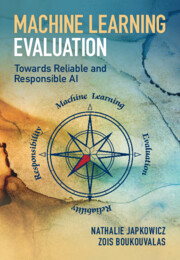Book contents
- Frontmatter
- Dedication
- Contents
- Abbreviations
- Preface
- Acknowledgments
- Part I Preliminary Considerations
- 1 Introduction
- 2 Statistics Overview
- 3 Machine Learning Preliminaries
- 4 Traditional Machine Learning Evaluation
- Part II Evaluation for Classification
- Part III Evaluation for Other Settings
- Part IV Evaluation from a Practical Perspective
- Appendices
- References
- Index
4 - Traditional Machine Learning Evaluation
from Part I - Preliminary Considerations
Published online by Cambridge University Press: 07 November 2024
- Frontmatter
- Dedication
- Contents
- Abbreviations
- Preface
- Acknowledgments
- Part I Preliminary Considerations
- 1 Introduction
- 2 Statistics Overview
- 3 Machine Learning Preliminaries
- 4 Traditional Machine Learning Evaluation
- Part II Evaluation for Classification
- Part III Evaluation for Other Settings
- Part IV Evaluation from a Practical Perspective
- Appendices
- References
- Index
Summary
Chapter 4 reviews frequently used machine learning evaluation procedures. In particular, it presents popular evaluation metrics for binary and multi-class classification (e.g., accuracy, precision/recall, ROC analysis), regression analysis (e.g., mean squared error, root mean squared error, R-squared error), clustering (e.g., Davies–Bouldin Index). It then reviews popular resampling approaches (e.g.,holdout, cross-validation) and statistical tests (e.g., the t-test and the sign test). It concludes with an explanation of why it is important to go beyond these well-known methods in order to achieve reliable evaluation results in all cases.
- Type
- Chapter
- Information
- Machine Learning EvaluationTowards Reliable and Responsible AI, pp. 51 - 80Publisher: Cambridge University PressPrint publication year: 2024

